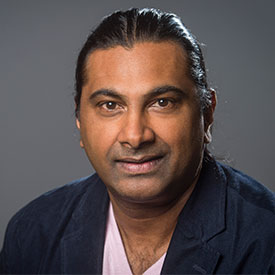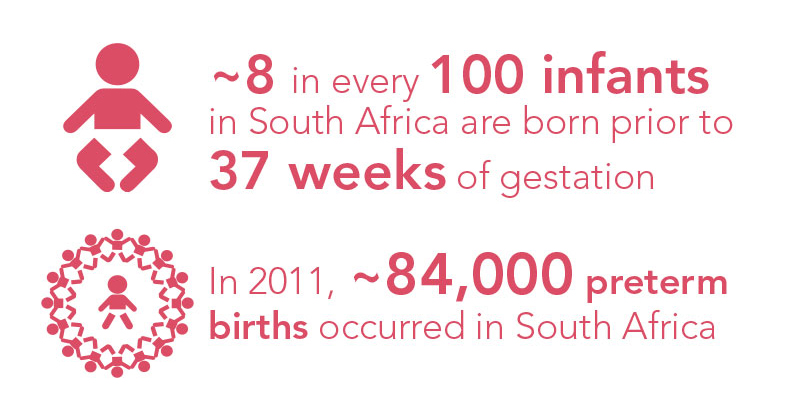 Rubin Pillay, assistant dean for global health innovation, led the Gates Foundation grant effort.Major international health foundations and organizations are taking notice of the School of Medicine’s increasingly robust global health programs. In fall 2015, the school received two of three $2.5 million grants awarded by the Bill & Melinda Gates Foundation to address pregnancy-related problems in South Africa. The grant effort was led was Rubin Pillay, M.D., Ph.D., assistant dean for global health innovation at the School of Medicine.
Rubin Pillay, assistant dean for global health innovation, led the Gates Foundation grant effort.Major international health foundations and organizations are taking notice of the School of Medicine’s increasingly robust global health programs. In fall 2015, the school received two of three $2.5 million grants awarded by the Bill & Melinda Gates Foundation to address pregnancy-related problems in South Africa. The grant effort was led was Rubin Pillay, M.D., Ph.D., assistant dean for global health innovation at the School of Medicine.
The Gates Foundation’s All Children Thriving initiative focuses on developing new technologies and approaches to ensure a healthy birth for mothers and children. “The grant challenge received 54 letters of intent from around the world, of which nine were invited to make full submissions,” says Pillay. “We were invited to make three full submissions, and of the three grant awards that were made, we received two.”
One of the projects is to develop a cervical ring to detect and prevent pre-term labor. In South Africa, approximately eight out of every 100 infants are born prior to 37 weeks of gestation; in 2011 there were approximately 84,000 preterm births in South Africa.
 A short cervical length is one of the best predictors of spontaneous preterm birth, and studies suggest that the two most effective interventions for women diagnosed with cervical shortening are the use of vaginal progesterone and a cervical pessary (a medical device that is placed at the opening to the cervix to close it). Many practitioners have made cervical length measurement part of their routine clinical practice along with a treatment plan of vaginal progesterone capsules or pessary placement in women with cervical shortening.
A short cervical length is one of the best predictors of spontaneous preterm birth, and studies suggest that the two most effective interventions for women diagnosed with cervical shortening are the use of vaginal progesterone and a cervical pessary (a medical device that is placed at the opening to the cervix to close it). Many practitioners have made cervical length measurement part of their routine clinical practice along with a treatment plan of vaginal progesterone capsules or pessary placement in women with cervical shortening.
Such a plan of care, however, requires the availability of an ultrasound machine capable of transvaginal cervical length measurement, a skilled ultrasound technologist, and the ability to appropriately disinfect the probe after use—significant barriers in developing areas. UAB’s project aims to develop an easy-to-use and cost-effective cervical pessary with sensors that link to a mobile phone that can alert women of cervical shortening and dilation, while progesterone embedded in the pessary can be administered to combat cervical shortening.
The goal of the second project is to develop a low-cost, one-time blood test for gestational diabetes. Currently, the diagnosis of gestational diabetes relies on glucose tolerance testing, which is expensive and time-consuming to administer. UAB researchers are working to develop an improved diagnostic method that is reproducible, inexpensive, requires only one blood draw, and can be performed at a wide range of gestational ages.
With the help of researchers at Sefako Makgatho Health Sciences University in Pretoria, South Africa, the study will recruit pregnant South African women at 20 to 28 weeks gestation who will be screened for gestational diabetes with routine glucose tolerance testing. Metabolomics analyses, an innovative technology that can measure thousands of analytes simultaneously, will be performed to identify unique biomarkers of gestational diabetes. Additional biomarkers of insulin resistance and hyperglycemia also will be measured. Researchers will then identify the biomarkers with the greatest sensitivity and specificity for gestational diabetes and combine them into a single test.
Pillay, who holds a joint appointment with UAB’s Collat School of Business as professor of health care innovation and entrepreneurship, says the model for these grants offers a useful exercise for the School of Medicine as the funding mechanisms for biomedical research continue to change. “The model is different from the typical NIH grant,” he says. “We get a certain amount now for seed funding and the rest of the award is contingent on successful delivery of a prototype. We’re running these as product development projects, so they’re going to be operated and managed in the manner you would a start-up business trying to develop and launch a new product.”
Pillay thinks that the product development aspect could produce long-lasting benefits for the Birmingham economy. “While we’re developing the cervical pessary we’re also hoping to spin off other products, like, for example, a sensor-based device to monitor cervical dilation of women in labor, so women don’t need to be digitally examined every hour. A big part of the future of health care is going to involve sensor-based technology, so I think this project will provide invaluable lessons and expertise for local scientists and researchers.”
By Jane Longshore